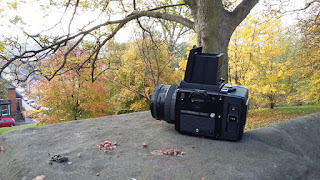As the sun crests the ridge of south common the valley of Lincoln is bathed in a bright warm light, it is a wonderful way to start a walk of discovery into the city. My route takes me across a bridge of a long forgotten disused and derelict railway line, Now claimed by nature and rubbish. I zip through the fast moving traffic on the main and up a twitten into the peacefulness of the back to backs.
I have the Bronica SQAi with 80mm lens in hand it is loaded with a roll of
35mm Kentmere 100 it will be exposed at box. The day is bright, the light
meter is tell me the apertures will be sufficiently small to give good depth of
field. Two firsts in one go the film and the streets.
 These street are a warren of terraced houses Presenting the walker with views
and insights of the city that most miss. Giving the walk a sense of adventure
and revaluation at what maybe round the next corner. The sun slants in across
the roof tops casting long shadows with crisp sharp edges leading the eye this
way and that. Making it look more picturesque than it is. The streets are
scattered with the detritus of living and communities that have lost pride in
there surrounding not helped by councils that have a despotic and petty
attitude to those that live here.
These street are a warren of terraced houses Presenting the walker with views
and insights of the city that most miss. Giving the walk a sense of adventure
and revaluation at what maybe round the next corner. The sun slants in across
the roof tops casting long shadows with crisp sharp edges leading the eye this
way and that. Making it look more picturesque than it is. The streets are
scattered with the detritus of living and communities that have lost pride in
there surrounding not helped by councils that have a despotic and petty
attitude to those that live here.
My head is on a swivel as I hunt for interesting insights to the city. Although the camera is fitted with an 80mm lens which is considered a wide angle for medium format it acts as a standard lens with 35mm bringing the subjects closer than expected. I have modified the focusing screen so when I look down I can see at a glance whether a composition will work. With a subject that has had such a loose remit to start with I have noticed the images are randomly falling into different themes care of my subconscious. The allure of this is that you are never stuck for a good picture.
Some people would say that I'm a traditionalist for using black and white film for this project I'm inclined to disagree because I am not of that ilk. It has become clear that the project has defined itself its about the harsh realities of living in a city that is dominated by a university culture and tourism that only monochrome can convey a more abstract grittiness and beauty all rolled into one.
If I am honest this project was all about getting out and about with the camera a way of shacking off the restraints of lock down. To break a stay at home attitude before it became a problem. I had not realized that my subconscious had an agenda.
In case you missed the first part of the street photography project here is a link Street P1
Film used 120 6 x 6 negative film used FP4+ at box, Fomapan 100 at box. 35mm Kentmere 100 at box for the last picture.
All words and pictures are the copyright of Mitch Fusco 2022 all rights reserved.















